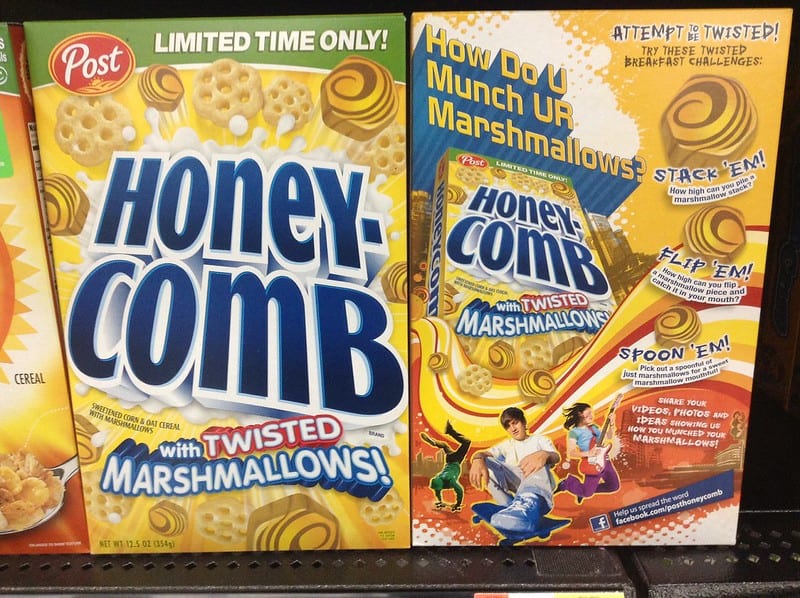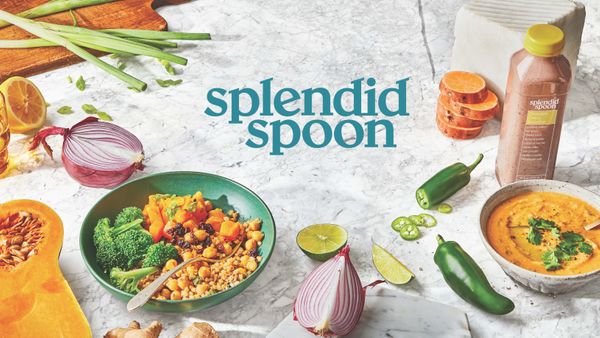Popular since the 1960’s, this product from Post Consumer Brands has been a sweet staple on the breakfast table for many families, but is Honeycomb cereal vegan? The answer is no unless you are less strict about certain ingredients.
We’re going to look at the main offenders, and see if there are any plant-based alternatives available.
Honeycomb Ingredients
Fortified vitamins and minerals add to the ingredients, and there are problematic stand-outs for each of them.
Let’s start with a rundown of the Post Honeycomb ingredients before investigating the non-vegan issues:
Corn Flour, Sugar, Whole Grain Oat Flour, Whole Grain Corn Flour, Honey, Salt, Yellow 5. Bht Added To Packaging Material To Preserve Product Freshness. Vitamins And Minerals: Niacinamide (B Vitamin), Reduced Iron, Zinc Oxide (Source Of Zinc), Vitamin B6, Vitamin A Palmitate, Riboflavin (Vitamin B2), Thiamin Mononitrate (Vitamin B1), Folic Acid (B Vitamin), Vitamin B12, Vitamin D. Manufactured On Equipment That Processes Wheat.
Sugar
It is no wonder Honeycomb cereal is ‘deliciously sweet’ but this isn’t the issue, it’s the not knowing how it is processed. There is always a risk of bone char being used to decolorize sugar in food items produced in the US.
Made from the charred bones of cattle and pigs, it bleaches sugar to make it a more desirable white. Although there is no trace of it in sugar after, there is still a question of ethics that cannot be ignored.
Because the supply chain is not exactly transparent it can be hard to tell which companies use bone char, so many vegans will consider this a grey area.
To be sure a product does not use bone char, look for organic sugar or sugar derived from beets or coconut.
Honey
An animal-derived ingredient is another grey area for some vegans, although most will see it as a deal-breaker.
Taking honey away from bees means you are depriving them of their food source, which can end up with a lot of dead bees.
Bees do not make their honey for us, so it is considered a form of animal exploitation by many vegans. The honey content in Honeycomb cereal will be enough for most to choose to avoid it, if only they had used maple syrup instead.
The subject of honey is a contentious one. Because there are commercially managed honeybees that are used to pollinate key crops, many vegans are likely to be enjoying the fruits of their labor.
They are techniques used to grow avocados, kiwi, squash, and a bunch of other fruits and vegetables which is why some vegans can turn a blind eye to its inclusion in certain products.
Artificial Color – Yellow 5
This is another controversial ingredient. Although it is not animal-derived and made from petroleum byproducts, artificial colors are routinely tested on animals.
Because of this, many will choose to avoid products that use it, although it is another that non-strict vegans will be able to ignore.
Yellow 5 has also been linked to causing hyperactivity in children and is used to color food yellow, which makes sense since Honeycomb cereal has that golden yellow look.
Vitamin D
Although Post Consumer Brands do not specify if this is vitamin D2 or D3, it is more common for cereals to be fortified with D3.
Another common assumption is that their D3 is animal-derived, and made from lanolin, or ‘sheep grease’!
It may sound bad, and to vegans, it will be since this is the waxy substance that sheep produce to waterproof their coats. Post Consumer Brands advise that the D3 they use is animal-derived, and since it is the more affordable method of producing D3, it is hardly surprising to see.
There are vegan sources, and D2 is always vegan friendly, but this version in Honeycomb cereal is probably not.
Non-Vegan Ingredients
Post-Consumer Brands confirmed on their website that many of their products can be considered vegan, but have advised that they use four animal-derived ingredients:
Most of our breakfast cereal products are vegetarian, excluding those containing gelatin, and many may be considered vegan, but not necessarily labeled this way.
Here are some common animal-derived ingredients to look for:
- Gelatin
- Honey
- Dairy
- Vitamin D3
Two of these can be found in Honeycomb cereal and this also adds further confirmation that the vitamin D3 they use is sourced from lanolin.
The main culprits in their cereal tend to be vitamin D3 and honey. These can be found in other cereals they produce such as their Honey Bunches of Oats range.
Is There Dairy In Honeycomb Cereal?
There is not. This is usually good news as the likes of whey, milk, butter, and other dairy sources can creep into some cereal, but there are other ingredients to make this product non-vegan anyway.
Is There Gelatin In Honeycomb Cereal?
There is no gelatin in Honeycomb cereal, but Post Consumer Brands has confirmed above that some of their products do contain this ingredient.
Vegan Alternatives
Protein and Gluten-Free Breakfast Cereal by Three Wishes – Honey Flavored
Although you see the word honey here, do not panic! These are vegan-friendly and made to taste like the real thing without the cruelty.
The ingredients include organic cane sugar so there is no risk of bone char from being used in the process and they say these have 2.5 x the protein of other honey-flavored cereals. The ingredients are simple, plant-based, and read as follows:
Chickpea, Tapioca, Pea Protein, Organic Cane Sugar, Natural Flavors, Monk Fruit
Love Grown Sea Stars Cereal, Fruity
When looking for something vegan that appeals to the kids, something colorful can be just the thing.
There is a decent amount of protein from the beans used, and they use vegetable juice for color so nothing artificial, and although there is cane sugar so there is a risk of bone char, they are listed on PETA’s kids vegan cereal brands. Here are the ingredients:
Bean blend (navy beans, lentils, garbanzo beans), brown rice flour, cane sugar, natural flavor, salt, sunflower lecithin, vegetable juice for color (radish and purple sweet potato), citric acid, turmeric, paprika, vitamin E (to maintain freshness).
Final Word
With so many cereals using honey, it can be difficult to get your vegan hands on something the family will love that is plant-based.
Still, it can make it easy to see which flavors you should avoid in the supermarket, and with vegan alternatives out there, you never have to go without a convenient bowl of cereal in the morning.
Featured image by Mike Mozart (CC BY 2.0)



